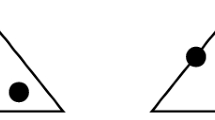Abstract
This paper is the first part of an extended program to develop a theory of fracture in the context of strain-limiting theories of elasticity. This program exploits a novel approach to modeling the mechanical response of elastic, that is non-dissipative, materials through implicit constitutive relations. The particular class of models studied here can also be viewed as arising from an explicit theory in which the displacement gradient is specified to be a nonlinear function of stress. This modeling construct generalizes the classical Cauchy and Green theories of elasticity which are included as special cases. It was conjectured that special forms of these implicit theories that limit strains to physically realistic maximum levels even for arbitrarily large stresses would be ideal for modeling fracture by offering a modeling paradigm that avoids the crack-tip strain singularities characteristic of classical fracture theories. The simplest fracture setting in which to explore this conjecture is anti-plane shear. It is demonstrated herein that for a specific choice of strain-limiting elasticity theory, crack-tip strains do indeed remain bounded. Moreover, the theory predicts a bounded stress field in the neighborhood of a crack-tip and a cusp-shaped opening displacement. The results confirm the conjecture that use of a strain limiting explicit theory in which the displacement gradient is given as a function of stress for modeling the bulk constitutive behavior obviates the necessity of introducing ad hoc modeling constructs such as crack-tip cohesive or process zones in order to correct the unphysical stress and strain singularities predicted by classical linear elastic fracture mechanics.
Similar content being viewed by others
References
Beatty MF, Hayes MA (1992) Deformations of an elastic, internally constrained material. Part i: homogeneous deformations. J Elast 29: 1–84
Broberg KB (1999) Cracks and fracture. Academic Press, San Diego, CA
Bustamante R, Rajagopal KR (2010) A note on plane stress and plane strain problems for a new class of elastic bodies. Math Mech Solid 15: 229–238
Cherepanov GP (1998) Fracture. Krieger Publishing Company, Malabar, FL
Kaninnen MF, Popelar CH (1985) Advanced fracture mechanics. Oxford University Press, New York, NY
Knowles JK, Sternberg E (1983) Large deformation near a tip of an interface-crack between two neo-hookean sheets. J Elast 13: 257–293
Noether E (1918) Invariante variationprobleme. Nachr D Lönig Gesellsch D Wiss zu Göttingen, Math-phys Klasse pp 235–257
Rajagopal KR (2003) On implicit constitutive theories. Appl Math 48: 279–319
Rajagopal KR (2007) Elasticity of elasticity. Zeitschrift für Angewandte Mathematik und Physik 58: 309–317
Rajagopal KR (2010) Non-linear elastic bodies exhibiting limiting small strain. Math Mech Solids
Rajagopal KR, Saccomandi G (2009) The mechanics and mathematics of the effect of pressure on the shear modulus of elastomers. Proc R Soc Lond 465: 3859–3874
Rajagopal KR, Srinivasa AR (2007) On the response of non-dissipative solids. Proc R Soc Lond 463: 357–367
Rajagopal KR, Srinivasa AR (2009) On a class of non-dissipative materials that are not hyperelastic. Proc R Soc Lond 465: 493–500
Sendova T, Walton JR (2010) A new approach to the modeling and analysis of fracture through extension of continuum mechanics to the nanoscale. Math Mech Solids 15: 368–413
Spencer AJM (1971) Theory of invariants. In: Eringen AC (eds) Continuum physics I, (Part III). Academic Press, New York, pp 239–353
Tarantino AM (1997) Nonlinear fracture mechanics for an elastic bell material. Quart J Mech Appl Math 50: 436–456
Todhunter I (1886) A history of the theory of elasticity and strength of materials, vol I: from Galilei to St. Venant C. J Clay Sons. University Press, Cambridge
Author information
Authors and Affiliations
Corresponding author
Additional information
The work of KRR on this publication was partially supported by the Office of Naval Research, while the work of JRW was supported in part by the Air Force Office of Scientific Research and by Award No. KUS-C1-016-04 made by King Abdullah University of Science and Technology (KAUST).
Rights and permissions
About this article
Cite this article
Rajagopal, K.R., Walton, J.R. Modeling fracture in the context of a strain-limiting theory of elasticity: a single anti-plane shear crack. Int J Fract 169, 39–48 (2011). https://doi.org/10.1007/s10704-010-9581-7
Received:
Accepted:
Published:
Issue Date:
DOI: https://doi.org/10.1007/s10704-010-9581-7




